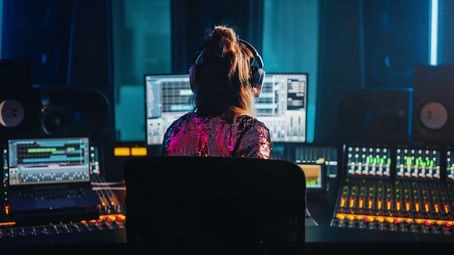Understanding the Music Online Marketing Landscape
The norms of music marketing have changed quickly in the digital era. This blog article is for you if you enjoy music and want to grasp the subtleties of this transition or if you are an aspiring musician. We will go deeply into the ever-changing realm of music internet marketing, investigate important trends, and provide doable plans to enable you to have a strong online presence.
The Evolution of Music Marketing
From conventional marketing strategies to digital marketing, the music business has witnessed a radical change. Print coverage, radio play, and actual sales dominated traditional marketing. Although these techniques were popular in their day, independent musicians typically lacked access to them, and were expensive.
Digital marketing has transformed the way music is distributed and enjoyed with the internet’s introduction. Digital channels provide direct and reasonably priced means of reaching consumers all over.
Direct mail, print advertisements, and billboards have been supplanted online by social media, email campaigns, and commercials. This change has democratized music promotion so that independent musicians may compete on an equal playing field with big labels.
Still, this change presents difficulties. Given the packed digital terrain, artists must differentiate between original and interesting material.
Spotify, Apple Music, and Tidal among other streaming services have changed the way music is distributed. Instead of having to buy individual albums or tracks, users may now access millions of music for a monthly membership cost.
This translates for artists into more reach and fresh income sources. These sites’ algorithms could expose your music to potential admirers who would never have come across you otherwise. Particularly playlists have evolved into a vital instrument for exploration and marketing.
Still, the money from streaming is much less per play than from conventional album sales. Artists must therefore discover other income sources using the great visibility streaming services provide.

The capacity to interact personally with followers is one of the most important benefits of digital marketing. Social media sites such as Instagram, Twitter, and TikHub make real-time audience interaction possible for artists.
Direct fan participation fosters loyalty and a community centered on your music. It gives people a feeling of connection and belonging, which increases their likelihood of supporting your career via retail sales, concert attendance, and crowdsourcing.
Direct participation, meanwhile, calls for a time commitment. Maintaining and expanding your audience depends mostly on regular involvement and sincere communication.
Key Players in the Music Online Marketing Industry
Rising Competency
The internet era has reduced musicians’ entrance barrier, therefore producing an explosion of fresh talent. This democratisation brings more competition even if it is a good thing. Being unique in a market this packed calls for imagination, tenacity, and a strong awareness of your consumers.
Modifying Customer Attitudes
The listeners of today have more options than they had years ago. From anywhere in the globe, at any moment, they may listen to music from any genre. This abundance array options has shortened attention spans and made loyalty more difficult to acquire.
Data-Driven Choice-Making
Data rules the universe of digital marketing. Musicians may monitor campaign performance, gauge audience involvement, and make educated choices by use of analytics technologies.
Data-driven decision-making lets you maximize your marketing plans, better manage resources, and produce outcomes. Reviewing and evaluating your data often can help you keep ahead of trends and change with the times to fit the always-shifting digital terrain.
Trends and Challenges in Music Online Marketing
Consuming music nowadays mostly comes via streaming sources. Among the most often used are Spotify, Apple Music, and Tidal, each of which presents special tools and chances for musicians.
For instance, Spotify offers comprehensive data with Spotify for Artists, thereby enabling you to monitor your performance and grasp your audience. While Tidal concentrates on high-fidelity sound quality and unique material, Apple Music provides exclusive releases and live radio events.
Knowing the special qualities and advantages of every platform will enable you to efficiently use them for your marketing campaigns.
Social Media Networks for Artists
Music marketing may benefit much from social media’s potent instrument. Unmatched chances to contact and interact with followers abound on sites such as Instagram, Twitter, TikHub, and YouTube.
Instagram and Twitter are excellent for posting updates, behind-the-scenes material, and fan interaction. With its emphasis on short-form video material, TikHub has grown to be a destination for music discovery and viral challenges. Still, a major venue for music videos, live events, and vlogs is YouTube.
Every platform boasts strengths and best practices. Effective use of them will enable you to maximize your influence and reach.
Marketing Companies for Influencers
Promoting music now mostly relies on influencer marketing. Working with influencers can help you establish trust and access fresh markets.
Companies specializing in influencer marketing focus on matching artists with relevant influencers. They may assist you in choosing appropriate partners, handle group projects, and track campaign performance.
Consider an influencer’s audience, interaction rates, and brand alignment before selecting one. A well-run influencer campaign may greatly increase your reputation and profile.
Building a Strong Online Presence for Musicians
Creating a Compelling Artist Brand
Your brand is your artistic identity. It covers your music, images, style, and moral compass. A strong brand enables you to connect with your customers and stand out.
The first step is realizing your target audience. Their tastes, values, and interests define who they are. Match your brand to theirs.
Developing a consistent visual identity is also quite vital. This covers your images, color scheme, typeface, and logo. Visual consistency promotes a brand that is identifiable and unforgettable.
Optimizing Social Media Platforms for Music Promotion
Your online presence is mostly composed of social media. First, produce interesting and shareable material to maximize your profiles for music marketing. Behind-the-scenes videos, live events, music videos, and fan interactions might all fit here.
Important is consistency. Share updates often and interact with your following. Respond to comments, engage in discussions, and thank you for your supporters.
Your exposure could also be raised by working with other musicians or influencers. Cross-promotion lets you reach new followers and leverage one another’s audiences.
Engaging with Fans through Email Marketing
Engaging with your fans through email marketing is a powerful way to build a strong connection and keep them updated on your latest music releases, upcoming shows, and exclusive content. By leveraging the power of email, you can reach your fans directly in their inbox, where they are more likely to engage with your message.

Personalization is key when it comes to email marketing. Tailor your emails to each fan by addressing them by name and including personalized recommendations based on their music preferences. This level of personalization shows your fans that you value them and their support.
Effective Strategies for Music Promotion
Utilizing Influencer Marketing to Reach a Wider Audience
Working with influencers can help you to increase your reputation and reach. Influencers have developed a following that accepts their advice. Working with them would let you expose your music to fresh ears.
Choose influencers whose target market fits your own. Authenticity is important; make sure the cooperation seems sincere and mutually beneficial.
Track your influencer efforts to gauge their influence. To find their success, examine engagement rates, follower increase, and conversions.
Harnessing the Power of Streaming Platforms
Music marketing requires streaming channels. Add connections to your social media networks, a strong bio, and top-notch photos to maximize your profile.
Making and selecting playlists could also help you be more visible. Present your music next to like-minded musicians to draw in fresh listeners. Talk to your audience via streaming media. Respond to comments, join in debates, and thank you for your support.
Musicians should take into account the following ideas if they want to properly maximize streaming platforms:
- Verify that your artist profile is full and aesthetically pleasing. To draw in potential admirers, use excellent pictures and interesting bio.
- Create playlists including your songs along with other musicians in your genre. This not only enhances your songs but also lets you network with artists and maybe work on projects.
- Comment on, message to, and live broadcast interact with your followers. Establishing a close relationship with your audience will help to boost loyalty and word-of-mouth advertising.
In addition to these strategies, it’s important to stay up-to-date with the latest trends and features offered by streaming platforms. Regularly check for new promotional opportunities, playlist placements, and algorithm updates that can help boost your visibility and reach.
Collaborating with Other Artists for Cross-Promotion
One effective approach to reach fresh audiences is via partnerships. Working with other musicians lets you leverage their fan bases and produce original work.
Clearly state your expectations and objectives for the cooperation. Make sure both sides gain from whichever kind of release—live performance, joint, or social media campaign.
Use the networks of each other to maximize the scope of your joint project. Promote the material on your accounts and inspire your followers to visit the other musician.
Data-Driven Approaches to Music Online Marketing
Analyzing Audience Insights for Targeted Marketing
Good marketing depends on your knowing of your audience. Get an understanding of the demographics, tastes, and activities of your audience by use of analytics technologies.
Sort important groups to customize your marketing initiatives. For instance, concentrate on platforms and materials that appeal to young people if your audience consists mostly of them. Review and evaluate your audience insights often to keep current and modify your plans.
Using Analytics to Measure Campaign Success
Analytics tools provide insightful information on how well your marketing initiatives are working. To gauge their success, track metrics including click-through, conversion, and engagement rates.
Examining your data often helps you find trends and patterns. This knowledge will help you to maximize your next campaigns and get greater results.
Implementing A/B Testing for Optimal Results
A/B testing is the comparison of many marketing components to ascertain which works best. Variations in ad wording, pictures, email subject lines and social media postings might all be included.
Testing several components can help you find what appeals most to your audience and guide wise, statistically-based selections. Frequent A/B testing can help you to always enhance your marketing plans and get the best outcomes.
Conclusion
Aspiring artists have many chances presented by the scene of internet music promotion. Understanding the development of music marketing, using important trends and players, and establishing a strong web presence can help you to properly advertise your music and attract a larger audience. Recall that maximizing your marketing initiatives depends on using data-driven decisions.
Are you prepared to improve your music business? Enrol in HyperTribe’s special membership to release your greatest potential. Joining a membership will provide you access to a plethora of tools, including customized marketing plans, networking chances, and professional assistance.



